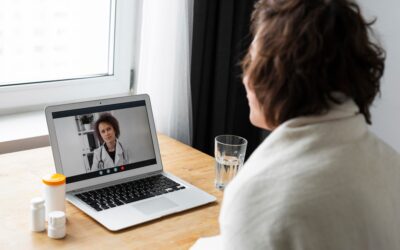
5 years ago, OneDoc launched its video consultation module. Conceived as a secure means of remote consultation in COVID time, video consultation has now established itself as a real alternative to face-to-face consultations for patients. In this interview, Dr. Jean Gabriel Jeannot gives us his take on this tool and when it can be used.
Could you briefly introduce yourself?
My name is Jean Gabriel Jeannot, and I’ve been a general internist in private practice in Neuchâtel for 23 years.
How did you find out about video consultations?
First in theory, when we discovered that teleconsultation was already in regular use in certain countries, and then in practice during the COVID-19 pandemic. There was a period at the start of the pandemic when doctors were only able to see their patients in their practices in very rare situations. Some of my colleagues didn’t even go into their practices any more, they had no contact with their patients. I was lucky enough to be able to continue working almost normally, but from home.
Even before the pandemic, I’d already started to have contact with my patients by telephone and email, for all those situations where a physical consultation wasn’t necessary. My patients and I were accustomed to maintaining contact, albeit not in person. During this period, I added video consultation to my practice. I was hesitant at first, as I wasn’t used to talking to my patients via video, but then I realised that this new way of treating patients was a real plus, bringing me closer to them. From a practical point of view, it was very simple because OneDoc offered a video solution integrated into its agenda from the start of the pandemic.
For what reasons do you use video consultation?
I’m convinced that video consultation is currently underused. I think the main reason is that doctors and patients are not used to this new way of doing healthcare. I offer my patients video consultations when I think that I don’t need to see them in person. Nevertheless, I still want a consultation that is as complete as possible, not just a telephone call. The image of the video consultation is an undeniable plus, particularly as it gives access to the patient’s body language.
On my agenda, I have time slots several times a week for video consultations. For me, the standard consultation remains a face-to-face consultation, but I want to be able to offer my patients the choice. I think that this new way of doing healthcare will develop and that in the future, more and more doctors will work from home one or two days a week.
Can you describe a use case for video consultation?
Although nothing will ever replace a physical consultation, there are many situations where a physical examination is not necessary. Teleconsultation is often seen as “sub-medicine”, I think this is false. Remote care can be just as good as face-to-face care, and it even has it’s own advantages. My patients who book video appointments do so mainly for practical reasons, because travelling to the practice is too time-consuming or complicated. I’m thinking, for example, of the single mother of three young children I saw on video recently, for whom a trip to the practice would have been quite an expedition. I also use video to follow-up on my patients with chronic pathologies, alternating with consultations at the practice.
Do you have any drawbacks to video consultations?
There are several drawbacks. First, of course, you can’t examine the patient. The second is that we have to integrate this new solution harmoniously into our daily work. The third is that we doctors are poorly trained in this practice, and therefore not always at ease. That’s why I recently set up the Telemedecine.ch website, where doctors can find everything they need to practice teleconsultation safely and effectively. I try to answer all questions there: from what the law says, to what good practice is, but also how to create an invoice or which video solution to choose, etc.
What equipment do I need to carry out high-quality video consultations?
To carry out high-quality video consultations, doctors need a computer or tablet with a webcam and built-in microphone. A fast, stable Internet connection is also essential to ensure smooth communication with patients. It is also preferable to consult from a neutral room, or to use features that allow the background to be blurred!




